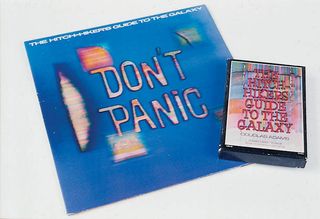
1 The first episode was broadcast on Radio 4 at 10.30pm on Wednesday 8 March 1978. “Much to Douglas’s annoyance,” Simon Jones (Arthur Dent) later recollected. “The BBC subsequently claimed it was its tried and true tack of turning something into a cult hit: putting it on when nobody would listen.”
2 The first radio series comprised six episodes, called “Fits” – a reference to the names of the sections of Lewis Carroll’s nonsense poem “The Hunting of the Snark”.
3 The series grew out of a proposal for a radio series called The Ends Of The Earth , which would have been six self-contained episodes, each ending with the destruction of our own planet. But when Adams came up with the idea of the Guide for one episode, it began to take over his thinking.
4 The show was an almost instant hit on the radio but BBC Enterprises was a bit slow to realise, initially turning down the chance to pick up the book rights. Instead Adams signed up with Pan for a £1,500 advance. A few weeks later the BBC came back to Adams to enquire about publishing rights. D’oh!
6 The first Hitchhiker’s stage production took place on 9 May 1979. It was directed by the legendary Ken Campbell. Narration was shared by two usherettes and Zaphod was played by two people in one costume. The audience (limited to 80 per performance) was seated on an indoor hovercraft.
7 The first radio series was briefly internally classified at the BBC as a drama rather than a comedy; this was so that it could be recorded in stereo and not in front of a live audience.
8 Superman The Movie beat The Hitchhiker’s Guide radio series for the Hugo Award for Best Dramatic Presentation in 1979, but even Christopher Reeve, accepting the award, said Hitchhiker’s should have won.
Sign up to the SFX Newsletter
Get sneak previews, exclusive competitions and details of special events each month!
9 Adams first used the famous Hitchhiker’s phrase “You may think it’s a long way down down the road to the chemist’s, but that’s just peanuts compared to space” in his 1974 monologue “Beyond The Infinite”
10 Much to Voice Of The Book Peter Jones’s bemusement (and his bank manager’s delight) the BBC re-recorded his contributions when the show was turned into a TV series: “I thought at the time, why didn’t they just use the radio narration again?’ There was probably some contractual problem about that.”
Read our review of “Shada”, the adaptation of the Douglas Adams
Doctor Who story, now finally being published as a novel
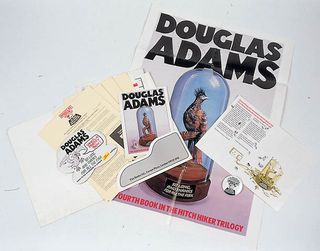
11 The TV series used various props and set elements from Ridley Scott’s Alien , most notably in the Vogon spaceship scenes.
12 You may know already that Doctor Who #5 Peter Davison had a guest appearance in the TV show under a lot latex as the Dish Of The Day. What is not such common knowledge however, is what made him decide to use a West Country accent. “Peter Davison played the pig that wanted to be eaten,” explains David (Darth Vader) Prowse, who was playing a bodyguard in the same episode. “They said, ‘Where did you get the accent?’ and he said, ‘Well, I listened to David Prowse talking…’”
13 The theme tune used for the radio series is a rerecorded version of “Journey of the Sorcerer”, an instrumental piece composed by Bernie Leadon and recorded by The Eagles on their album One of These Nights .
14 When the theme tune to the TV series was released as a single, the B-side featured Douglas Adams playing rhythm guitar.
16 None of the computer graphics for the Guide in the TV series were created on computer. They were traditionally animated by Kevin Davies.
17 In December 1982 Douglas Adams became the first British author since Ian Fleming to have three books simultaneously in both The New York Times and Publisher’s Weekly bestsellers lists.
18 Ghostbusters ’ Ivan Reitman was once interested in making the film adaptation. Adams actually started writing the scripts.
19 In 1984 Sinclair Spectrum and C5 inventor Sir Clive Sinclair paid £1,000 to a charity of Adams’s choice to get his hands on a pre-publication copy of So Long And Thanks For All the Fish .
20 A lenticular of the cover of So Long And Thanks For All The Fish was given away as a free gift with Kellog’s Corn Flakes.
Read our interview with the author who has adapted the
Douglas Adams Doctor Who story, “Shada”
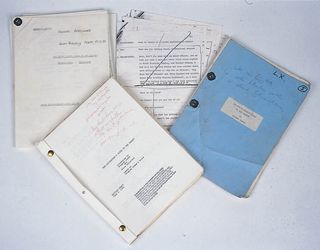
21 Don’t Panic: The Official Hitchhiker’s Guide To The Galaxy Companion , published in 1988, was co-written by Neil Gaiman.
22 Douglas Adams made a number of cameo appearances in the TV series: as one of the drinkers in the background of the pub in episode one; as the man who walks naked into the ocean in episode two; and as a member of the Sirius Cybernetic Marketing Division also in episode two.
23 He face was also used (in animated form) as the basis for an illustration of Paula Nancy Millstone Jennings (episode two) and he pops up again in animated form on the Guide in episode three.
24 Talking of the worst poet in the universe, in the original radio broadcast, she was a he, called Paul Neil Milne Johnstone, the name of a real classmate of Adams’s. But under threat of legal action, Adams altered the name slightly for the television series and novel.
26 Douglas Adams personally wrote the infamous Hitchhiker’s Guide text adventure computer game, which some claim to be the most brain-aching adventure game ever written. The most devious puzzle, involving the Babel Fish, was so legendarily devious, the game’s publisher, Infocom, wound up selling “I got the Babel Fish!” T-shirts.
27 The game come packaged with numerous “free gifts” including “Peril Sensitive Sunglasses” – basically a pair of sunglasses with blacked out lenses.
28 In the Doctor Who story “Destiny Of The Daleks” (which was script-edited by Adams) The Doctor is seen reading Oolon Colluphid’s book The Origins Of The Universe . Colluphid, of course, is the author of Where God Went Wrong and Some More of God’s Greatest Mistakes mentioned in Hitchhiker’s Guide.
29 The spaceman in the titles sequence of the TV show is Alan Harris.
30 Many of the costumes seen in episodes one to four of the series can be seen again during the Milliway’s sequences in episode five.
Read our review of “Shada”, the adaptation of the Douglas Adams
Doctor Who story, now finally being published as a novel
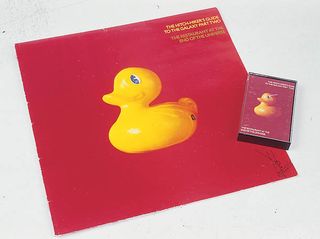
31 Adams, always renowned for missing deadlines, was still feverishly writing the scripts for the last two episode of the original radio series even as they were being recorded. Simon Jones (Arthur Dent) recalls asking where Adams was one day during a recording, only to be told he was in the toilet, writing the scripts on loo paper. This may have been a joke. But we’d like to think it’s true.
32 In the TV show, Zaphod’s third arm (when it wasn’t a dummy one tucked into his jacket) was played by special effect technician Mike Kelt, who had also built his second head.
33 According to Adams, the name Slartibartfast, was deliberately supposed to sound rude. It started out as Phartiphukborlz, but then he played around with the syllables until he had “something which sounded that rude, but was almost, but not quite, entirely inoffensive.”
34 In the movie version, the hymn sung by the Jatravartidian followers of Humma Kavula was recorded at St Martin’s Church, Highgate, London and featured several hundred untrained members of the public invited to the recording via a call for singers circulated on the Internet.
35 Three people have now provided the Voice of the Book: Peter Jones in the original radio series, William Franklyn in the new radio series and Stephen Fry in the film. Actually, make that four… sort of. Rula Lenska was a female version of the Voice in the later radio series too, when the Guide was “updated”.
36 The original TV Marvin makes a cameo in the film version, as does the theme tune.
37 David Dixon wore purple contact lenses to play Ford Prefect in the TV version. Though you can’t really tell.
38 An original idea for Zaphod’s fake head in the TV series was for two to be made, one that could fit on Mark Wing-Davey’s right shoulder, the other on his left, and they could be swapped accordingly. That way he could have always had his “real” head nearer the camera. This, of course, proved way too expensive.
39 Animated Kevin Davies once proposed a TV series based solely on the Guide’s animated graphics (admittedly there may have been some self-interest here).
40 When ITV arts magazine show The South Bank Show did a (typically odd) Douglas Adams special in 1992, they could only film Marvin from the waist up because they didn’t have the bottom half of the costume.
41 John Lloyd, who co-wrote the final couple of episodes of the original radio series with Adams (because of Adams’s workload) plundered ideas from his own comedy sci-fi novel Gigax which he was halfway through writing at the time.
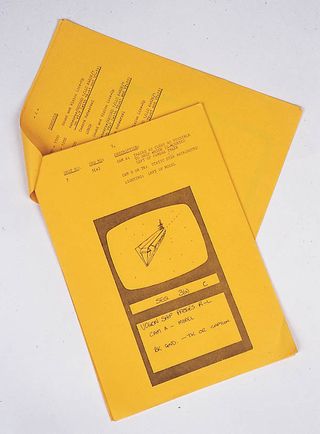
42 The origin of the number 42 as the answer to “life, the universe and everything” is as murky as most stories in the real life Hitchhiker’s universe. Adams initially claimed that he chose 42 as it was a “reassuring number” and not an obviously joke number “like 17 3/4.” “I didn’t want fractions in it. I didn’t even want it to be a prime number. And I guess it shouldn’t be an odd number,” he said. “There is something slightly more reassuring about even numbers. 42 is an unfrightening number.”
Later he claimed inspiration from the group Procol Harum, one of whose songs featured “someone going off to find enlightenment”, only to find the answer was extraordinarily banal. Another origin story points towards John Cleese, who was working on a Video Arts training film with Adams and who came up with the number “42” as the most ordinary number he could think of as the punchline to a sketch.
But another story claims Cleese’s one-time writing partner Graham Chapman (who wasn’t at the training shoot) came up with 42 to Douglas as the answer to life, the universe and everything. The claim, made in a posthumously-published collection of Chapman material, was vehemently denied by Adams before his death. Sometime later, however, Cleese confirmed that he and Chapman had come up with the idea of 42 as the funniest number sometime in the 1960s.
Read our interview with the author who has adapted the
Douglas Adams Doctor Who story, “Shada”
SFX Magazine is the world's number one sci-fi, fantasy, and horror magazine published by Future PLC. Established in 1995, SFX Magazine prides itself on writing for its fans, welcoming geeks, collectors, and aficionados into its readership for over 25 years. Covering films, TV shows, books, comics, games, merch, and more, SFX Magazine is published every month. If you love it, chances are we do too and you'll find it in SFX.
Most Popular



